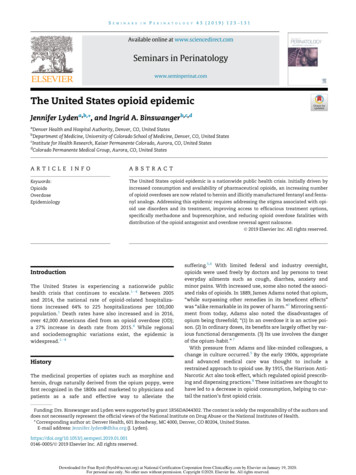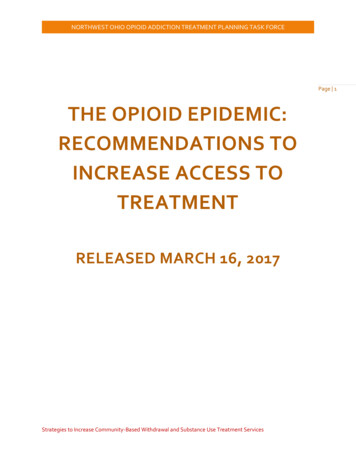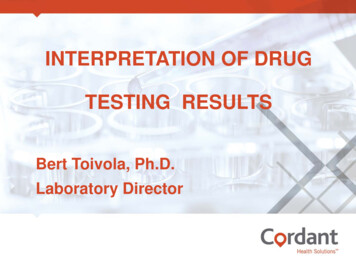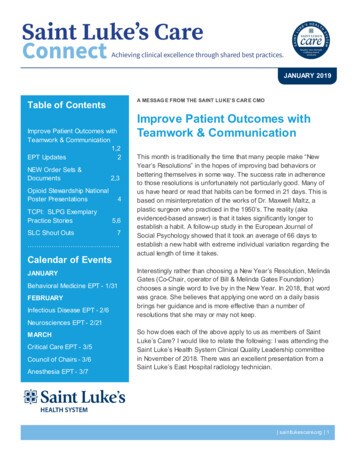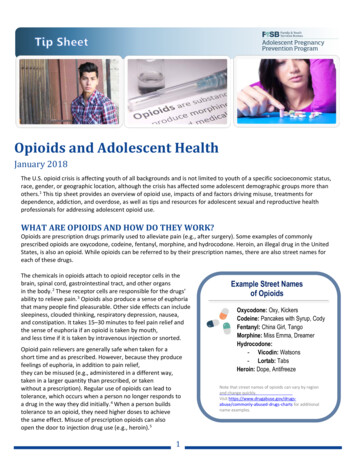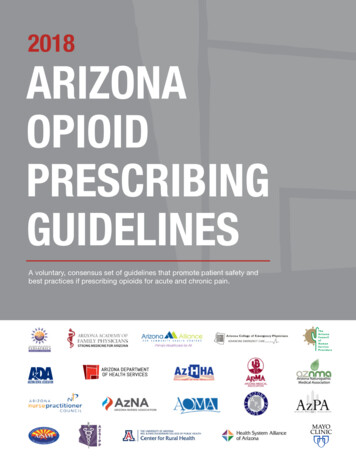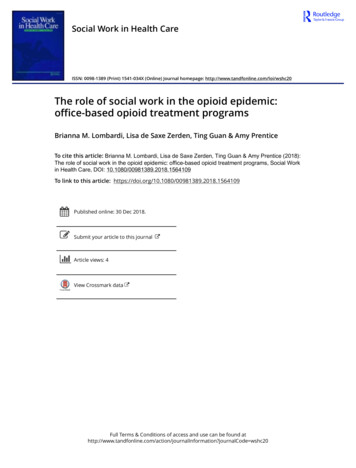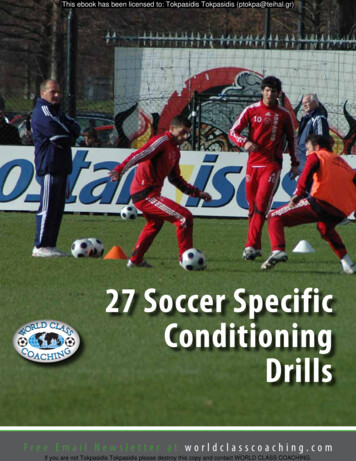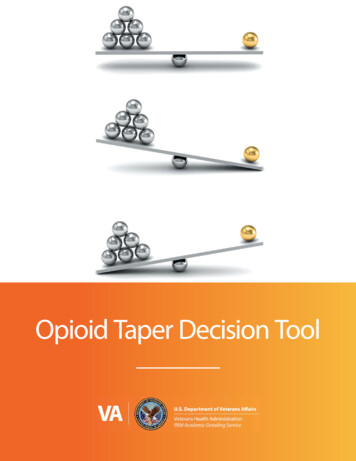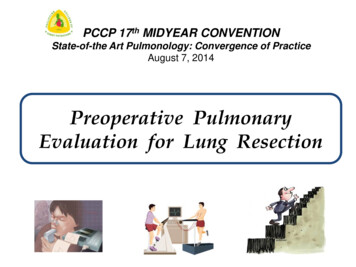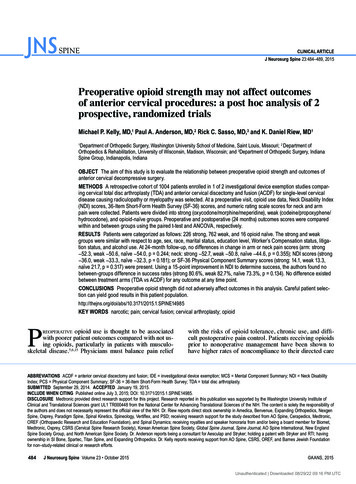
Transcription
spineclinical articleJ Neurosurg Spine 23:484–489, 2015Preoperative opioid strength may not affect outcomesof anterior cervical procedures: a post hoc analysis of 2prospective, randomized trialsMichael P. Kelly, MD,1 Paul A. Anderson, MD,2 Rick C. Sasso, MD,3 and K. Daniel Riew, MD1Department of Orthopedic Surgery, Washington University School of Medicine, Saint Louis, Missouri; 2 Department ofOrthopedics & Rehabilitation, University of Wisconsin, Madison, Wisconsin; and 3Department of Orthopedic Surgery, IndianaSpine Group, Indianapolis, Indiana1Object The aim of this study is to evaluate the relationship between preoperative opioid strength and outcomes ofanterior cervical decompressive surgery.Methods A retrospective cohort of 1004 patients enrolled in 1 of 2 investigational device exemption studies comparing cervical total disc arthroplasty (TDA) and anterior cervical discectomy and fusion (ACDF) for single-level cervicaldisease causing radiculopathy or myelopathy was selected. At a preoperative visit, opioid use data, Neck Disability Index(NDI) scores, 36-Item Short-Form Health Survey (SF-36) scores, and numeric rating scale scores for neck and armpain were collected. Patients were divided into strong (oxycodone/morphine/meperidine), weak (codeine/propoxyphene/hydrocodone), and opioid-naïve groups. Preoperative and postoperative (24 months) outcomes scores were comparedwithin and between groups using the paired t-test and ANCOVA, respectively.Results Patients were categorized as follows: 226 strong, 762 weak, and 16 opioid naïve. The strong and weakgroups were similar with respect to age, sex, race, marital status, education level, Worker’s Compensation status, litigation status, and alcohol use. At 24-month follow-up, no differences in change in arm or neck pain scores (arm: strong-52.3, weak -50.6, naïve -54.0, p 0.244; neck: strong -52.7, weak -50.8, naïve -44.6, p 0.355); NDI scores (strong-36.0, weak -33.3, naïve -32.3, p 0.181); or SF-36 Physical Component Summary scores (strong: 14.1, weak 13.3,naïve 21.7, p 0.317) were present. Using a 15-point improvement in NDI to determine success, the authors found nobetween-groups difference in success rates (strong 80.6%, weak 82.7%, naïve 73.3%, p 0.134). No difference existedbetween treatment arms (TDA vs ACDF) for any outcome at any time point.Conclusions Preoperative opioid strength did not adversely affect outcomes in this analysis. Careful patient selection can yield good results in this patient 1.SPINE14985PKey Words narcotic; pain; cervical fusion; cervical arthroplasty; opioidopioid use is thought to be associatedwith poorer patient outcomes compared with not using opioids, particularly in patients with musculoskeletal disease.5,6,15 Physicians must balance pain reliefreoperativewith the risks of opioid tolerance, chronic use, and difficult postoperative pain control. Patients receiving opioidsprior to nonoperative management have been shown tohave higher rates of noncompliance to their directed careAbbreviations ACDF anterior cervical discectomy and fusion; IDE investigational device exemption; MCS Mental Component Summary; NDI Neck DisabilityIndex; PCS Physical Component Summary; SF-36 36-Item Short-Form Health Survey; TDA total disc arthroplasty.submitted September 29, 2014. accepted January 19, 2015.include when citing Published online July 3, 2015; DOI: 10.3171/2015.1.SPINE14985.Disclosure Medtronic provided direct research support for this project. Research reported in this publication was supported by the Washington University Institute ofClinical and Translational Sciences grant UL1 TR000448 from the National Center for Advancing Translational Sciences of the NIH. The content is solely the responsibility ofthe authors and does not necessarily represent the official view of the NIH. Dr. Riew reports direct stock ownership in Amedica, Benvenue, Expanding Orthopedics, NexgenSpine, Osprey, Paradigm Spine, Spinal Kinetics, Spineology, Vertiflex, and PSD; receiving research support for the study described from AO Spine, Cerapedics, Medtronic,OREF (Orthopaedic Research and Education Foundation), and Spinal Dynamics; receiving royalties and speaker honoraria from and/or being a board member for Biomet,Medtronic, Osprey, CSRS (Cervical Spine Research Society), Korean American Spine Society, Global Spine Journal, Spine Journal, AO Spine International, New EnglandSpine Society Group, and North American Spine Society. Dr. Anderson reports being a consultant for Aesculap and Stryker; holding a patent with Stryker and RTI; havingownership in SI Bone, Spartec, Titan Spine, and Expanding Orthopedics. Dr. Kelly reports receiving support from AO Spine, CSRS, OREF, and Barnes Jewish Foundationfor non–study-related clinical or research efforts.484J Neurosurg Spine Volume 23 October 2015 AANS, 2015Unauthenticated Downloaded 08/29/22 09:16 PM UTC
Opioid use in anterior cervical surgeryand also undergo surgery more frequently than those without pretreatment narcotics. Additionally, opioid toleranceand opioid-induced hyperalgesia may complicate postoperative care and negatively affect outcomes related withsurgery. These concerns are supported in studies of bothtotal knee arthroplasty and cervical discectomy and fusionpatients.6,15Anterior cervical discectomy and fusion (ACDF) andcervical total disc arthroplasty (TDA) are used in themanagement of both radiculopathy and myelopathy withexcellent success.4,8,9,12 Several studies have investigatedoutcome predictors of these anterior decompressive procedures.1,10 Among reported predictors of poor results wereexposure to lower-strength opioids, high disability scores,and higher preoperative pain scores. That lower-strengthopioids would be associated with poor results is counterintuitive, and the effect of preoperative opioid exposureon the results of anterior decompressive surgery has notbeen well examined. We hypothesized that exposure tostrong opioids prior to an anterior cervical decompressiveprocedure would be associated with less improvement inoutcomes scores. To investigate this hypothesis, we soughtto measure the association between preoperative opioidstrength and patient-centered outcomes following ACDFand TDA from 2 prospective, randomized, controlled trials.MethodsA post hoc analysis of data from 2 prospective, multicenter, randomized U.S. Food and Drug Administrationinvestigational device exemption (IDE) studies was performed. These studies compared the Prestige cervical arthroplasty and the Bryan cervical arthroplasty (MedtronicSofamor Danek) (TDA) with ACDF for the managementof single-level cervical disc disease. The protocols forthese studies have been previously published.4,8 Institutional review board approval was obtained at all participating centers. Informed consent for study participationwas obtained from all patients. All patients presented withsingle-level, degenerative cervical disc disease causingradiculopathy, myelopathy, or both and a Neck DisabilityIndex (NDI) score equal to or greater than 30. All patientshad symptoms for a minimum of 6 weeks and underwent6 weeks of nonoperative management, unless they continued to show neurological deterioration. Pertinent exclusioncriteria included any prior cervical spine surgery, diabetes mellitus, inflammatory arthropathies (e.g., rheumatoidarthritis), or evidence of segmental instability on flexionextension films. Patients with a medical condition treatedwith long-term steroids or nonsteroidal antiinflammatorymedications were also excluded. Patients with prior oractive histories of alcohol or drug abuse or dependencywere excluded. All patients were treated with an anteriordecompressive procedure, with either ACDF or TDA. Allpatients were given routine postoperative care.At enrollment, all patients responded to a questionnaireregarding their narcotic use. Opioid use was recorded onintake forms as “weak” narcotic medication (e.g., codeine,propoxyphene, hydrocodone) or “strong” narcotic medication (e.g., oxycodone, morphine, meperidine), accordingto morphine equivalents and standard prescribed dosages.Patients were thus categorized into the following groups:opioid naïve, weak opioid, and strong opioid. In additionto standard demographic information, 36-Item Short-FormHealth Survey (SF-36) scores, NDI scores, and numericpain rating scores for arm pain and neck pain were obtained at the baseline, 6-month, 12-month, and 24-monthfollow-up visits. Success was defined as a 15-point orgreater improvement in the NDI. Patients were asked ifthey felt surgery was a success or failure, if surgery was aseffective as they had hoped, and if they would have chosensurgery again for the same condition. Return to work wasevaluated at each follow-up visit.Preoperative and postoperative scores were comparedwithin groups, using the Student t-test, and betweengroups, using ANCOVA, at each time point, using preoperative scores as a covariate. Logistic regression was usedto compare the dichotomous outcome of success, controlling for preoperative NDI scores. SAS statistical softwarewas used. Statistical significance was defined as p 0.05.ResultsPatient DemographicsThere were 1004 patients identified with baseline andfollow-up data in the 2 IDE studies. Of these, 226 patients(22.5%) reported use of strong opioids at the time of enrollment, and 762 patients (75.9%) reported use of weakopioids at the time of enrollment. Only 16 patients (1.6%)reported no narcotic use at the time of enrollment. Given the small size of the opioid-naïve group, no statisticalcomparisons were made between this group and the weakor strong groups, and only comparisons between the lattertwo groups were performed.The mean age of enrolled patients was similar betweengroups, and sex and race were distributed similarly between groups (Table 1). Marital status, level of maximumeducation, and alcohol use were similar among groups.Tobacco use was significantly more common in thestrong opioid group (38.5%) versus the weak opioid group(27.8%). Patients in the strong opioid group were less likely to be working prior to surgery, when compared withweak opioid users (52.2% and 68.2%, p 0.001).Baseline Severity of DiseasePatients taking strong narcotics had higher baselineNDI scores, more neck pain, and more arm pain thanthe weak opioid cohort (Tables 2–4). Preoperative SF-36Physical Component Summary (PCS) scores were lowerin the strong opioid group (more disability), though thedifference was small and perhaps of no clinical meaning(strong: 29.2 12.4; weak: 32.9 14.4, p 0.001; naïve:31.0 12.0). Similarly, a small, but statistically significant,difference in preoperative SF-36 Mental Component Summary (MCS) scores was observed, with the strong opioidgroup showing slightly more disability (strong: 40.3 24.0; weak: 43.7 24.2; p 0.001, naïve: 46.5 28.4).OutcomesMean improvement in NDI score was 36.3 points in thestrong and 33.5 points in the weak cohorts. This differJ Neurosurg Spine Volume 23 October 2015485Unauthenticated Downloaded 08/29/22 09:16 PM UTC
M. P. Kelly et al.TABLE 1. Demographic dataVariableStrong Opioid n 226Mean age in yrs (SD)Sex, n (%)MFRace, n (%)CaucasianAfrican AmericanAsianHispanicOtherWorker’s Compensation, n (%)YesNoLitigation, n (%)YesNoTobacco use (%)Alcohol use (%)Work status (%)43.4 (8.0)Weak Opioid n 762p Value*Naïve n 1644.1 (8.3)0.21747.6 (6.9)104 (46)122 (54)362 (47.5)400 (52.5)0.7057 (43.8)9 (56.3)211 (93.4)5 (2.2)1 (0.4)6 (2.7)3 (1.3)713 (93.6)21 (2.8)5 (0.7)17 (2.2)6 (0.8)0.88514 (87.5)1 (6.3)001 (6.3)27 (12.2)194 (87.8)66 (8.7)689 (93.5)0.151016 (100)13 (5.9)208 (94.1)38.526.152.249 (6.5)706 (93.5)27.830.268.20.876016 (100)0.003†0.2450.001†12.5* The p values are from ANOVA for continuous variables and from Fisher’s test for categorical variables.† Statistically significant.ence was not statistically significant, p 0.181 (Table 2).Success, as defined by 15 point NDI improvement, was notdifferent between groups at any time point, and no difference in this outcome measure was present between groupsat any follow-up time point (Table 5).Significant improvement from baseline in arm painand neck pain was seen in both weak and strong opioidcohorts, and no differences in arm or neck pain scoreswere present at any follow-up time point (Tables 3 and 4).No significant differences in SF-36 PCS score improvements were present at any follow-up time point (Table 6).Statistically significant differences in SF-36 MCS scoreswere present, although they did not meet the minimumclinically important difference and are of minimal clinicalsignificance.Patient-perceived results and patient satisfaction weresimilar among groups at all follow-up time points (Table7). Return to work was similar between groups at all follow-up time points. Adverse events reported during the24-month follow-up period were similar between groups,including events related to reports of neck or arm pain andStrong OpioidPreop6 months12 months24 months60.2 (15.2, 226)24.9 (21.3, 188)23.3 (21.8, 202)23.9 (23.1, 191)Weak OpioidpValue†Naïve51.9 (15.3, 761)19.8 (18.9, 704)18.6 (19.1, 700)18.4 (19.4, 690)—0.2520.4540.18144.8 (14.7, 16)20.6 (18.6, 14)14.3 (19.0, 15)12.7 (16.9, 15)* Values are mean NDI score (SD, number of patients).† The p values comparing means are from ANCOVA, with preoperative scoreas a covariate.486DiscussionThe use of opioids in the initial management of musculoskeletal disease is becoming increasingly common.2 Inthis analysis of 1004 patients with cervical radiculopathyor myelopathy, only 1.6% of patients were narcotic naïveat the time of enrollment. The American Society of Interventional Pain Physicians has stated that opioid medications may be effective for short-term use in acute pain;however, use that becomes chronic is increasing.13 Further,opioids do not appear to be as effective for neuropathicpain as they are for allodynic pain, and, therefore, are generally less effective in the study population.11 This chronicuse of opioids is concerning as it may lead to tolerance,TABLE 3. Arm pain assessed using numeric rating scale†TABLE 2. NDI scores across groups*TimePointother pain. There were no differences at any time pointin patient satisfaction with the results of the surgery between groups. There were no differences in outcomeswhen groups were divided by treatment received (ACDFor TDA).Follow-UpTime PointStrong Opioid Weak Opioidn 226n 762p ValueNaïven 16Preop (SD)6 months12 months24 months77.7 (21.5)25.9 ( 51.8)23.5 ( 54.2)25.4 ( 52.3) 0.001*0.328**0.864**0.244**72.2 (21.6)28.3 ( 43.9)20.2 ( 52.0)18.2 ( 54.00)72.0 (22.8)22.1 ( 49.9)22.6 ( 49.4)21.4 ( 50.6)* From independent-sample t-test.** The p values for comparing treatment groups are from ANCOVA, with thepreoperative score as the covariate.† Unless otherwise stated, values are mean score (change from baseline).J Neurosurg Spine Volume 23 October 2015Unauthenticated Downloaded 08/29/22 09:16 PM UTC
Opioid use in anterior cervical surgeryTABLE 4. Neck pain assessed using numeric rating scale†Follow-UpTime PointStrong Opioidn 226Weak Opioidn 762p ValueNaïven 16Preop (SD)6 months12 months24 months84.6 (15.4)34.5 ( 50.1)31.5 ( 53.1)33.9 ( 52.7)77.6 (18.3)29.9 ( 47.7)27.6 ( 50.0)26.8 ( 50.8) 0.001*0.431**0.549**0.355**67.7 (29.3)23.9 ( 43.8)28.1 ( 39.6)23.1 ( 44.6)* From independent-sample t-test.** The p values for comparing treatment groups are from ANCOVA, with thepreoperative score as the covariate.† Unless otherwise stated, values are mean score (change from baseline).with escalating doses of opiates, and to opioid-inducedhyperalgesia, with paradoxical pain in response to opioid exposure. Both may influence the poor outcomes observed in the nonoperative and operative management ofmusculoskeletal disease, including cervical degenerativedisease.1,3,6,14,15 Higher doses of opiates have been correlated with higher complaints of disability, higher rates oftreatment noncompliance, and higher rates of surgery. Areasonable fear is that use of stronger opioids may be associated with worse outcomes in anterior cervical decompressive procedures, such as ACDF and TDA.In this post hoc analysis of data obtained from 2 prospective, randomized, controlled trials of anterior cervicaldecompressive procedures for single-level radiculopathyor myelopathy we have found no evidence that preoperative narcotic strength affected outcomes. Disease-specificmeasures (arm pain, neck pain, NDI) and measures ofgeneral health (SF-36 PCS) were similar at all follow-upvisits for patients with histories of use of either weak orstrong opioids. Unfortunately, narcotic-naïve patients wereso rare that statistical comparisons were not possible forthis group. Nonetheless, the results of the naïve group appear similar to the strong and weak groups. No differencein success rates, as defined by a minimum of 15 point improvement in the NDI, was present at any time point between groups, and patients were similarly pleased with theresults of the surgery at all follow-up time points.It is difficult to contrast the results of this study withprior works investigating the use of opioids and anteriorcervical surgery.1,6 Lawrence et al. examined the results of91 consecutive patients treated with ACDF for cervical radiculopathy.6 Though the outcome measures reported arenot validated, these authors reported good results in only51% of patients receiving opioids for 6 months or more before surgery versus good results in 86% of the opioid-naïve group. The chronic opioid group had 32% poor resultswhile the opioid-naïve group had no poor results. Theyconclude that surgeons must counsel patients regardingthe risk of poor results after surgery if they have takenopioids for more than 6 months prior to surgery. Theirconclusions agree with the findings in total joint arthroplasty, where preoperative opioid intake has been associated with poor results.3,15 These studies do not comparethe results associated with differing relative strengths ofopioids used. The results of our study show that patientsreceiving high strength opioid pain medications can experience good results and deem their surgeries “successful.”TABLE 5. Success across groups*Time PointStrongOpioidWeakOpioidp Value†Naïve6 months12 months24 months157 (83.5)169 (83.7)154 (80.6)562 (79.9)573 (82.0)570 (82.7)0.7780.8800.13410 (71.4)11 (73.3)11 (73.3)* Success is defined as a minimum 15-point improvement in NDI score. Allvalues are number (%) of patients.† The p values comparing success are from logistic regression adjusted bythe preoperative NDI score.Unfortunately, we are not able to compare opioid-naïvepatients with the strong and weak strength groups. Ananalysis of patients undergoing ACDF in 2 IDE studiesfound work status, higher disability scores, litigation, andimpaired sensory function were associated with poor outcomes.1 The strength of the preoperative opioid did notinfluence results. Our results suggest a similar conclusion.There are, however, several limitations to this study.We are unable to quantify the dose and duration of preoperative opioid use. Thus, we are unable to calculate amorphine equivalent dose for a more uniform comparisonof preoperative intake and any association with results. Insome cases, those taking weak opioids may have takenquantities larger than strong opioid patients. At the extreme, the weak opioid cohort may have taken higher morphine equivalent dosing, on average, though the results ofthe study would be unchanged. Also, we are unable toquantify the duration of symptoms in any patient. Patientswith chronic pain and chronic opioid exposure may nothave been offered the opportunity to participate in thesestudies. As a result, there also may be demographic differences between patients deemed candidates for enrollmentand those not offered enrollment, which limit the generalizability of our data. The excellent overall results confirmthe importance of patient selection for surgery as was presumably done in the rigidly administered trials.Also a concern with chronic or high dose opioid use isopioid-induced hyperalgesia, where opioid exposure potentiates rather than alleviates pain. While chronic exposure is often associated with this phenomenon, both acuteand chronic use can result in this condition.7 A comparison with a narcotic-naïve group is desirable, to evaluateany effect that opioids may have on outcomes, though thiswas not possible with these data, given the paucity of opioid-naïve patients. That so few patients were opioid naïvepoints to the ubiquity of the use of opioids in the nonoperative management of cervical degenerative disease withneck and arm pain. The IDE trials excluded patients withhistories of drug or alcohol abuse, again limiting the generalizability of the results and highlighting the importanceof careful patient selection. Finally, these data come from2 trials investigating single-level cervical disease. It standsto reason that these findings would transfer to multilevelsurgery for radiculopathy or myelopathy, though this maynot be the case.Despite the aforementioned limitations, these data support the idea that opioid strength may not adversely affectoutcomes in anterior cervical decompressive procedures.J Neurosurg Spine Volume 23 October 2015487Unauthenticated Downloaded 08/29/22 09:16 PM UTC
M. P. Kelly et al.TABLE 6. SF-36 scores across groups*Follow-Up Time Point & VariablePreopPCSMCS6 monthsPCSMCS12 monthsPCSMCS24 monthsPCSMCSStrong OpioidWeak Opioidp Value†Naïve29.2 (6.2, 226)40.3 (12.0, 226)32.9 (7.2, 761)43.7 (12.1, 761)42.3 (11.8, 186)47.9 (12.0, 186)45.4 (11.1, 700)51.2 (10.5, 700)43.8 (11.7, 201)47.7 (12.6, 201)45.8 (11.2, 697)51.6 (10.3, 697)0.990 0.001‡49.0 (10.3, 15)53.0 (9.0, 15)43.5 (12.4, 189)47.8 (12.3, 189)46.3 (11.4, 683)51.5 (10.4, 683)0.3170.003‡51.2 (8.2, 14)51.8 (11.9, 14)31.0 (6.0, 13)46.5 (14.2, 13)0.1490.0008‡16.7 (13.8, 11)51.4 (11.7, 13)* All values are mean score (SD, number of patients).† p values are from ANCOVA, with preoperative score as a covariate.‡ Represents statistical significance.It is unlikely that any prospective cohort will be able to enroll a similar number of patients, which is a strength of thedata presented here. The weaknesses of this study shouldbe used to help guide the design of a prospective, obser-vational cohort study. To confirm, or refute, these conclusions, a study will need to collect duration of symptoms,duration of opioid use, average daily morphine equivalentopioid consumption, and postoperative opioid use. Such aTABLE 7. Patient perception and satisfaction results*Assessment ItemI am satisfied with the results of my surgeryI was helped as much as I thought I would beI would have the surgery for this condition againPt Perception atFollow-Up6 monthsYesNo12 monthsYesNo24 monthsYesNo6 monthsYesNo12 monthsYesNo24 monthsYesNo6 monthsYesNo12 monthsYesNo24 monthsYesNoStrong Opioidn 226Weak Opioidn 762164 (87.2)24 (12.8)608 (86.7)93 (13.3)0.90413 (92.9)1 (7.1)176 (87.1)26 (12.9)577 (82.7)121 (17.3)0.71315 (100)0167 (87.4)24 (12.6)603 (86.6)93 (13.4)0.13014 (93.3)1 (7.1)156 (83.4)31 (16.6)577 (82.7)121 (17.3)0.91313 (92.9)1 (7.1)168 (83.2)34 (16.8)574 (82.4)123 (17.6)0.83415 (100)0160 (84.7)29 (15.3)587 (87.3)99 (14.4)0.72913 (86.7)2 (13.3)167 (89.3)20 (10.7)603 (86.6)93 (13.4)0.38914 (93.3)1 (6.7)177 (88.1)24 (11.9)610 (87.9)84 (12.1)1.00013 (86.7)2 (13.3)171 (90.5)18 (9.5)596 (87.3)87 (12.7)0.25713 (86.7)2 (13.3)p Value†Naïven 16Pt patient.* All values are number (%) of patients.† The p values are from Fisher’s exact test.488J Neurosurg Spine Volume 23 October 2015Unauthenticated Downloaded 08/29/22 09:16 PM UTC
Opioid use in anterior cervical surgerystudy is necessary given the common use of opioids in thenonoperative management of these pathologies.ConclusionsIn this post hoc analysis of data obtained from 2 prospective IDE trials, we found no association between preoperative narcotic intake and poor outcomes followinganterior decompressive surgery for single-level cervicaldisease. The prevalence of narcotic use in the nonoperative management of these pathologies is high, with fewnarcotic-naïve patients enrolled in either study. Despitethe prevalence of opioid use, no difference was observedbetween patients taking high or low strength opioids, andgood results were obtained in the majority of cases. Thesedata will aid surgeons in counseling patients prior to anterior cervical decompressive surgeries for single-leveldisease and confirm the importance of careful patient selection when performing these procedures. These resultsshould allay fears of surgeons that high strength narcoticuse precludes good results following the treatment of single-level cervical degenerative disease.References1. Anderson PA, Subach BR, Riew KD: Predictors of outcomeafter anterior cervical discectomy and fusion: a multivariateanalysis. Spine (Phila Pa 1976) 34:161–166, 20092. Caudill-Slosberg MA, Schwartz LM, Woloshin S: Officevisits and analgesic prescriptions for musculoskeletal pain inUS: 1980 vs. 2000. Pain 109:514–519, 20043. Franklin PD, Karbassi JA, Li W, Yang W, Ayers DC: Reduction in narcotic use after primary total knee arthroplasty andassociation with patient pain relief and satisfaction. J Arthroplasty 25 (6 Suppl):12–16, 20104. Heller JG, Sasso RC, Papadopoulos SM, Anderson PA, Fessler RG, Hacker RJ, et al: Comparison of BRYAN cervicaldisc arthroplasty with anterior cervical decompression andfusion: clinical and radiographic results of a randomized,controlled, clinical trial. Spine (Phila Pa 1976) 34:101–107,20095. Kidner CL, Mayer TG, Gatchel RJ: Higher opioid doses predict poorer functional outcome in patients with chronic disabling occupational musculoskeletal disorders. J Bone JointSurg Am 91:919–927, 20096. Lawrence JT, London N, Bohlman HH, Chin KR: Preoperative narcotic use as a predictor of clinical outcome: resultsfollowing anterior cervical arthrodesis. Spine (Phila Pa1976) 33:2074–2078, 20087. Lee M, Silverman SM, Hansen H, Patel VB, ManchikantiL: A comprehensive review of opioid-induced hyperalgesia.Pain Physician 14:145–161, 20118. Mummaneni PV, Burkus JK, Haid RW, Traynelis VC, Zde-9.10.11.12.13.14.15.blick TA: Clinical and radiographic analysis of cervical discarthroplasty compared with allograft fusion: a randomizedcontrolled clinical trial. J Neurosurg Spine 6:198–209, 2007Murrey D, Janssen M, Delamarter R, Goldstein J, Zigler J,Tay B, et al: Results of the prospective, randomized, controlled multicenter Food and Drug Administration investigational device exemption study of the ProDisc-C total discreplacement versus anterior discectomy and fusion for thetreatment of 1-level symptomatic cervical disc disease. SpineJ 9:275–286, 2009Peolsson A, Vavruch L, Oberg B: Predictive factors for armpain, neck pain, neck specific disability and health after anterior cervical decompression and fusion. Acta Neurochir(Wien) 148:167–173, 2006Phillips WJ, Currier BL: Analgesic pharmacology: I. Neurophysiology. J Am Acad Orthop Surg 12:213–220, 2004Riew KD, Buchowski JM, Sasso R, Zdeblick T, Metcalf NH,Anderson PA: Cervical disc arthroplasty compared with arthrodesis for the treatment of myelopathy. J Bone Joint SurgAm 90:2354–2364, 2008Trescot AM, Helm S, Hansen H, Benyamin R, Glaser SE,Adlaka R, et al: Opioids in the management of chronic noncancer pain: an update of American Society of the Interventional Pain Physicians’ (ASIPP) Guidelines. Pain Physician11 (2 Suppl):S5–S62, 2008Webster BS, Verma SK, Gatchel RJ: Relationship betweenearly opioid prescribing for acute occupational low back painand disability duration, medical costs, subsequent surgeryand late opioid use. Spine (Phila Pa 1976) 32:2127–2132,2007Zywiel MG, Stroh DA, Lee SY, Bonutti PM, Mont MA:Chronic opioid use prior to total knee arthroplasty. J BoneJoint Surg Am 93:1988–1993, 2011Author ContributionsConception and design: Kelly, Riew. Acquisition of data:Anderson, Sasso, Riew. Analysis and interpretation of data:Kelly, Anderson. Drafting the article: Kelly. Critically revisingthe article: all authors. Reviewed submitted version of manuscript: all authors. Approved the final version of the manuscripton behalf of all authors: Kelly.Supplemental InformationPrevious PresentationPortions of this work were presented in 2012 in abstract form atthe 40th Annual Meeting of the Cervical Spine Research Society(December 6–8, Chicago, Illinois).CorrespondenceMichael P. Kelly, Department of Orthopedic Surgery, Institutesof Health, 5th Fl., Washington University School of Medicine,660 S. Euclid Ave., Saint Louis, MO 63110. email: kellymi@wudosis.wustl.edu.J Neurosurg Spine Volume 23 October 2015489Unauthenticated Downloaded 08/29/22 09:16 PM UTC
total knee arthroplasty and cervical discectomy and fusion patients.6,15 Anterior cervical discectomy and fusion (ACDF) and cervical total disc arthroplasty (TDA) are used in the management of both radiculopathy and myelopathy with excellent success.4,8,9,12 Several studies have investigated outcome predictors of these anterior decompressive .
